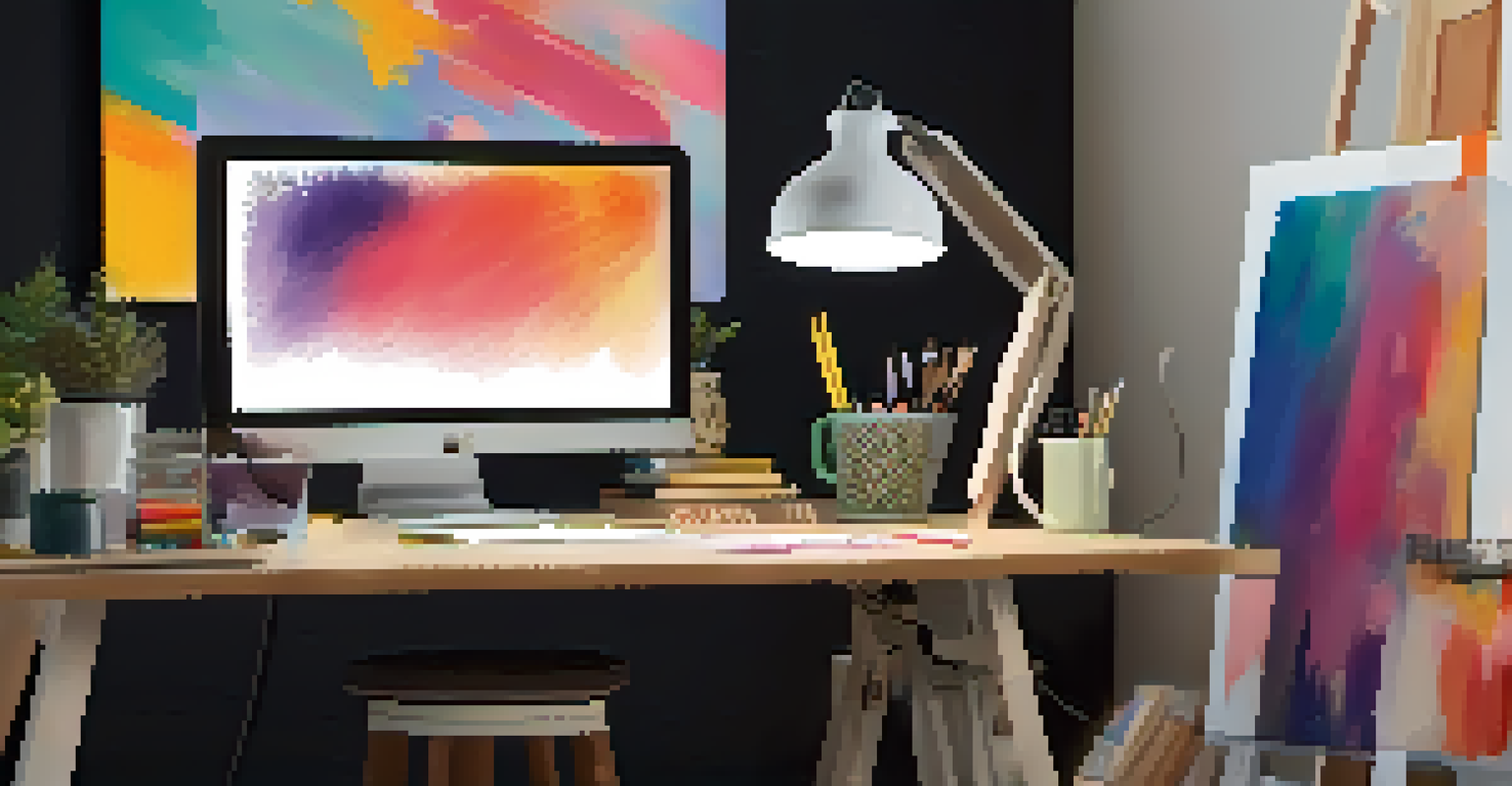The Role of Color Theory in Digital Art and Design Explained

What is Color Theory and Why It Matters
Color theory is a framework that explains how colors interact with each other and how they can be combined effectively. It serves as a foundation for artists and designers, helping them to create visually appealing work. Understanding color theory can enhance the emotional impact of a piece, guiding the viewer’s experience and response.
Colors are the smiles of nature.
At its core, color theory involves the color wheel, which categorizes colors into primary, secondary, and tertiary groups. This wheel not only helps in mixing colors but also in understanding complementary colors, which can create a dynamic visual contrast. Think of it as the musical scale for artists, where each color has its own note and harmony.
In digital art and design, applying color theory can profoundly influence branding, user experience, and storytelling. For instance, a vibrant color palette might evoke excitement, while softer tones can create a sense of calm. By grasping these principles, creators can make informed choices that resonate with their audience.
The Psychological Impact of Color Choices
Colors can evoke strong emotions and associations, a concept explored extensively in color psychology. For example, red often signifies passion or urgency, while blue tends to convey trust and tranquility. This emotional resonance can be a powerful tool in digital art and design, allowing creators to influence their audience's feelings.

When designing a website or a marketing campaign, the colors chosen can significantly affect user engagement. A well-chosen color palette can lead to higher conversion rates, demonstrating that color is not just about aesthetics. It’s about creating a connection with the viewer, guiding them through an emotional journey.
Understanding Color Theory Basics
Color theory provides a framework for artists and designers to effectively combine colors for emotional impact and visual appeal.
For instance, consider a non-profit organization using green hues in their materials. This color often represents growth and healing, effectively aligning with their mission to promote environmental sustainability. By thoughtfully selecting colors, designers can reinforce their message and values.
The Color Wheel: A Designer’s Best Friend
The color wheel is a fundamental tool in color theory, illustrating the relationships between colors. It consists of primary colors (red, blue, yellow), secondary colors (green, orange, purple), and tertiary colors, which are combinations of primary and secondary hues. Understanding this wheel is crucial for any digital artist or designer.
Color is the keyboard, the eyes are the harmonies, the soul is the piano with many strings.
By leveraging the color wheel, artists can create harmonious color schemes. For example, complementary colors—those opposite each other on the wheel—can create vibrant contrasts that draw the eye. This is especially useful in digital design, where grabbing attention is often key to success.
Additionally, analogous colors, which are next to each other on the wheel, can create a more subtle and cohesive look. This balance between contrast and harmony is essential in guiding the viewer's eye and maintaining visual interest, making the color wheel an indispensable resource.
Color Schemes: Creating Cohesion in Design
Color schemes are organized combinations of colors that work well together, helping to create a cohesive visual identity. Common schemes include monochromatic, complementary, and triadic. Each scheme serves a different purpose and can evoke varying feelings and thoughts in the viewer.
For instance, a monochromatic color scheme uses different shades and tints of a single color. This approach can create a clean, sophisticated look, often seen in brands wanting to communicate elegance and simplicity. It allows for a unified aesthetic without overwhelming the viewer with too many colors.
Color's Emotional Influence
Colors evoke strong emotions, and selecting the right palette can significantly enhance user engagement and convey brand messages.
On the other hand, a complementary scheme can add energy and excitement to a design. By using colors that are opposite each other on the color wheel, designers can create striking visuals that stand out. This balance of cohesion and contrast is what makes effective color schemes so vital in digital art and design.
Using Color to Enhance User Experience
In digital design, color plays a pivotal role in enhancing user experience (UX). Colors can guide users’ attention, create visual hierarchy, and define interactive elements. For example, calls to action are often highlighted in bright colors to encourage clicks, making navigation intuitive and engaging.
Moreover, colors can influence how users perceive the usability of a product. A well-chosen color palette can make interfaces feel more approachable and friendly. Think about apps that use warm colors to create a sense of community; they invite users to engage and explore.
Conversely, poor color choices can lead to frustration and confusion. For instance, low-contrast text against a busy background can be hard to read, detracting from the overall experience. By prioritizing thoughtful color selections, designers can create user-friendly interfaces that resonate with their audience.
Cultural Significance of Colors in Design
Colors carry different meanings across cultures, making it essential for designers to consider cultural contexts. For example, while white often symbolizes purity in Western cultures, it can represent mourning in some Eastern cultures. This cultural significance can heavily influence how a design is perceived globally.
Designers must be mindful of these nuances, especially when targeting international audiences. A color that evokes a positive response in one culture might lead to misunderstandings in another. This awareness can help prevent costly missteps and foster a more inclusive approach to design.
Cultural Context in Color Design
Designers must consider cultural meanings of colors, as these can vary widely and impact how designs are perceived globally.
For instance, when creating marketing materials for a global brand, a designer might choose colors that are universally appealing or adapt the palette based on cultural insights. This thoughtfulness not only enhances the design but also shows respect for diverse audiences.
Trends in Color Usage for Digital Art
Color trends in digital art and design are ever-evolving, influenced by cultural shifts, technology, and artistic movements. Recently, there has been a rise in the use of vibrant, bold colors that demand attention. These trends often reflect the current societal mood, making it essential for designers to stay updated.
For instance, the trend toward brighter palettes can be seen in social media graphics and digital marketing campaigns. This shift towards bold colors often aims to capture the fast-paced attention of audiences scrolling through their feeds. By aligning with these trends, designers can ensure their work feels relevant and engaging.

Additionally, the resurgence of retro color schemes or muted tones shows how nostalgia influences design choices. Designers often draw inspiration from past eras, creating a sense of familiarity and warmth. By blending contemporary trends with timeless elements, digital artists can create work that resonates with a wide audience.